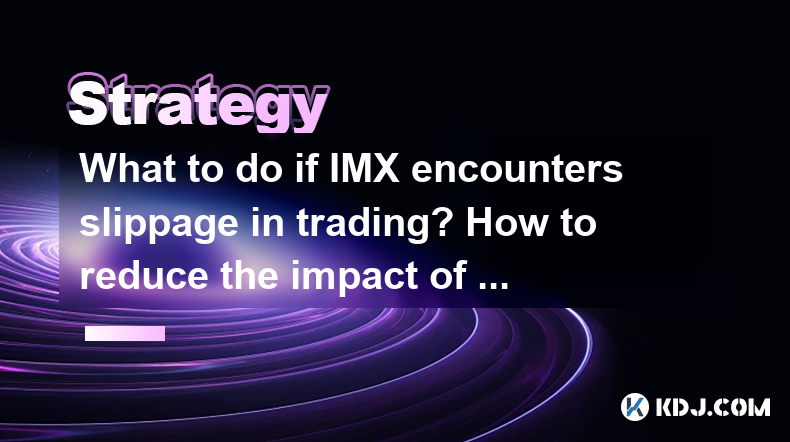-
 bitcoin
bitcoin $122025.899241 USD
-2.12% -
 ethereum
ethereum $4488.068729 USD
-4.11% -
 bnb
bnb $1315.348019 USD
8.65% -
 tether
tether $1.000457 USD
0.03% -
 xrp
xrp $2.875326 USD
-3.69% -
 solana
solana $222.043604 USD
-4.07% -
 usd-coin
usd-coin $0.999682 USD
0.00% -
 dogecoin
dogecoin $0.249887 USD
-5.62% -
 tron
tron $0.337379 USD
-2.59% -
 cardano
cardano $0.827763 USD
-5.06% -
 hyperliquid
hyperliquid $45.774531 USD
-2.43% -
 chainlink
chainlink $22.079309 USD
-5.87% -
 ethena-usde
ethena-usde $1.000156 USD
0.02% -
 sui
sui $3.482566 USD
-3.57% -
 stellar
stellar $0.386982 USD
-4.92%
What to do if IMX encounters slippage in trading? How to reduce the impact of slippage?
Slippage in IMX trading can be managed by monitoring market conditions, using limit orders, and trading during high liquidity periods to minimize its impact.
May 05, 2025 at 11:35 pm

When trading IMX (Immutable X) or any other cryptocurrency, slippage can be a frustrating issue that affects the execution of your trades. Slippage refers to the difference between the expected price of a trade and the price at which the trade is actually executed. This can occur due to market volatility, liquidity issues, or the time it takes for your order to be processed. In this article, we'll explore what you can do if you encounter slippage while trading IMX and how to reduce its impact.
Understanding Slippage in IMX Trading
Slippage is an inevitable part of trading in any financial market, including the cryptocurrency market. When trading IMX, slippage can occur for several reasons:
- Market Volatility: Rapid price changes can cause the price at which you place your order to differ from the price at which it is executed.
- Liquidity: If there isn't enough liquidity in the IMX market, your order might not be filled at the desired price.
- Order Size: Larger orders are more likely to experience slippage because they require more liquidity to fill.
Understanding these factors can help you anticipate and manage slippage more effectively.
Immediate Actions to Take When Encountering Slippage
If you notice slippage while trading IMX, there are several immediate steps you can take to mitigate its impact:
- Monitor Market Conditions: Keep a close eye on market trends and news that could affect IMX prices. This can help you anticipate potential slippage.
- Adjust Your Order: If you see that the market is moving rapidly, consider adjusting your order to a limit order instead of a market order. This can help you control the price at which your trade is executed.
- Use Stop-Loss Orders: Implementing stop-loss orders can help limit your losses if the price moves against your position due to slippage.
Strategies to Reduce Slippage in IMX Trading
To reduce the impact of slippage when trading IMX, you can employ several strategies:
- Trade During High Liquidity Periods: Liquidity tends to be higher during certain times of the day, such as when major markets are open. Trading during these periods can help reduce slippage.
- Use Smaller Order Sizes: Breaking up large orders into smaller ones can help minimize the impact of slippage. This allows you to fill your orders at more favorable prices.
- Utilize Slippage Tolerance Settings: Many trading platforms allow you to set a slippage tolerance, which specifies the maximum amount of slippage you are willing to accept. Setting this can help you avoid unfavorable trades.
Setting Up Slippage Tolerance on Trading Platforms
To set up slippage tolerance on a trading platform, follow these steps:
- Choose Your Trading Platform: Ensure that your chosen platform supports slippage tolerance settings. Popular platforms like Binance and Uniswap offer this feature.
- Access the Trading Interface: Navigate to the trading interface where you can place your orders.
- Select the Slippage Option: Look for the settings or options menu and find the slippage tolerance setting.
- Set Your Tolerance Level: Enter the percentage of slippage you are willing to accept. For example, setting a 1% tolerance means your order will only execute if the price does not deviate more than 1% from your specified price.
- Confirm and Place Your Order: After setting your slippage tolerance, confirm your order and place it on the market.
Using Limit Orders to Control Slippage
Limit orders can be an effective tool for managing slippage when trading IMX. Here's how to use them:
- Understand Limit Orders: A limit order allows you to specify the exact price at which you want to buy or sell IMX. It will only be executed if the market reaches your specified price.
- Set Your Limit Order: On your trading platform, choose to place a limit order instead of a market order. Enter the price at which you want to trade.
- Monitor and Adjust: Keep an eye on the market and be prepared to adjust your limit order if necessary. If the market moves away from your specified price, you may need to adjust your order to ensure it gets filled.
Additional Tips for Minimizing Slippage
Beyond the strategies and tools mentioned, here are some additional tips to help you minimize slippage when trading IMX:
- Stay Informed: Keep up-to-date with news and events that could affect IMX prices. Sudden news can cause rapid price movements, leading to slippage.
- Use Trading Bots: Some traders use automated trading bots to help manage their trades and minimize slippage. These bots can execute trades at optimal times and prices.
- Avoid Peak Times: While trading during high liquidity periods can reduce slippage, be cautious of peak times when volatility might be higher. Consider trading during less volatile periods if possible.
Frequently Asked Questions
Q: Can slippage be completely avoided when trading IMX?A: No, slippage cannot be completely avoided due to the inherent nature of financial markets. However, by using the strategies and tools mentioned, you can significantly reduce its impact.
Q: Does the type of cryptocurrency exchange affect slippage when trading IMX?A: Yes, the type of exchange can affect slippage. Centralized exchanges generally have higher liquidity and may experience less slippage compared to decentralized exchanges, which can have lower liquidity.
Q: How does the size of my IMX order affect slippage?A: Larger orders are more likely to experience slippage because they require more liquidity to fill. Breaking up large orders into smaller ones can help minimize slippage.
Q: Is there a specific time of day that is best for trading IMX to minimize slippage?A: Trading during times when major markets are open can help minimize slippage due to higher liquidity. However, this can vary depending on the specific market conditions and the time zone you are in.
Disclaimer:info@kdj.com
The information provided is not trading advice. kdj.com does not assume any responsibility for any investments made based on the information provided in this article. Cryptocurrencies are highly volatile and it is highly recommended that you invest with caution after thorough research!
If you believe that the content used on this website infringes your copyright, please contact us immediately (info@kdj.com) and we will delete it promptly.
- BlockDAG, DOGE, HYPE Sponsorship: Crypto Trends Shaping 2025
- 2025-10-01 00:25:13
- Deutsche Börse and Circle: A StableCoin Adoption Powerhouse in Europe
- 2025-10-01 00:25:13
- BlockDAG's Presale Buzz: Is It the Crypto to Watch in October 2025?
- 2025-10-01 00:30:13
- Bitcoin, Crypto, and IQ: When Genius Meets Digital Gold?
- 2025-10-01 00:30:13
- Stablecoins, American Innovation, and Wallet Tokens: The Next Frontier
- 2025-10-01 00:35:12
- NBU, Coins, and Crypto in Ukraine: A New Yorker's Take
- 2025-10-01 00:45:14
Related knowledge

Practical parameter settings for a Bitcoin multi-timeframe moving average system
Sep 18,2025 at 10:54pm
Optimizing Timeframe Combinations for Bitcoin Trading1. Selecting appropriate timeframes is crucial when building a multi-timeframe moving average sys...

How can I filter out false breakouts in Dogecoin high-frequency trading?
Sep 22,2025 at 01:00am
Understanding False Breakouts in Dogecoin Trading1. A false breakout occurs when Dogecoin's price appears to move beyond a defined support or resistan...

Techniques for identifying tops and bottoms in the Bitcoin on-chain NVT model
Sep 20,2025 at 07:54pm
Understanding the NVT Model in Bitcoin Analysis1. The Network Value to Transactions (NVT) ratio is often described as the 'P/E ratio' of the cryptocur...

What does the surge in open interest in Bitcoincoin futures mean?
Sep 20,2025 at 11:18pm
Understanding the Surge in Dogecoin Futures Open Interest1. A surge in open interest within Dogecoin futures indicates a growing number of active cont...

How can I use the Ethereum USDT premium to gauge market sentiment?
Sep 18,2025 at 11:55pm
Understanding the Ethereum USDT Premium1. The Ethereum USDT premium refers to the price difference between USDT (Tether) traded on Ethereum-based plat...

What should I do if Ethereum staking yields decline?
Sep 20,2025 at 06:18am
Understanding the Causes Behind Declining Ethereum Staking Yields1. The Ethereum network transitioned to a proof-of-stake consensus mechanism with the...

Practical parameter settings for a Bitcoin multi-timeframe moving average system
Sep 18,2025 at 10:54pm
Optimizing Timeframe Combinations for Bitcoin Trading1. Selecting appropriate timeframes is crucial when building a multi-timeframe moving average sys...

How can I filter out false breakouts in Dogecoin high-frequency trading?
Sep 22,2025 at 01:00am
Understanding False Breakouts in Dogecoin Trading1. A false breakout occurs when Dogecoin's price appears to move beyond a defined support or resistan...

Techniques for identifying tops and bottoms in the Bitcoin on-chain NVT model
Sep 20,2025 at 07:54pm
Understanding the NVT Model in Bitcoin Analysis1. The Network Value to Transactions (NVT) ratio is often described as the 'P/E ratio' of the cryptocur...

What does the surge in open interest in Bitcoincoin futures mean?
Sep 20,2025 at 11:18pm
Understanding the Surge in Dogecoin Futures Open Interest1. A surge in open interest within Dogecoin futures indicates a growing number of active cont...

How can I use the Ethereum USDT premium to gauge market sentiment?
Sep 18,2025 at 11:55pm
Understanding the Ethereum USDT Premium1. The Ethereum USDT premium refers to the price difference between USDT (Tether) traded on Ethereum-based plat...

What should I do if Ethereum staking yields decline?
Sep 20,2025 at 06:18am
Understanding the Causes Behind Declining Ethereum Staking Yields1. The Ethereum network transitioned to a proof-of-stake consensus mechanism with the...
See all articles










































































